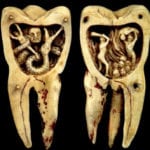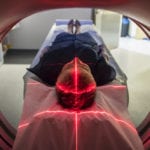 Weird Stuff
Weird Stuff  Weird Stuff
Weird Stuff  Our World
Our World 10 Ways Your Christmas Tree Is More Lit Than You Think
 Movies and TV
Movies and TV The 10 Coolest Stars to Set Sail on The Love Boat
 History
History 10 Things You Didn’t Know About the American National Anthem
 Technology
Technology Top 10 Everyday Tech Buzzwords That Hide a Darker Past
 Humans
Humans 10 Everyday Human Behaviors That Are Actually Survival Instincts
 Animals
Animals 10 Animals That Humiliated and Harmed Historical Leaders
 History
History 10 Most Influential Protests in Modern History
 Creepy
Creepy 10 More Representations of Death from Myth, Legend, and Folktale
 Technology
Technology 10 Scientific Breakthroughs of 2025 That’ll Change Everything
 Weird Stuff
Weird Stuff Ten Bizarre Facts About The Doge Meme
 Our World
Our World 10 Ways Your Christmas Tree Is More Lit Than You Think
 Movies and TV
Movies and TV The 10 Coolest Stars to Set Sail on The Love Boat
Who's Behind Listverse?

Jamie Frater
Head Editor
Jamie founded Listverse due to an insatiable desire to share fascinating, obscure, and bizarre facts. He has been a guest speaker on numerous national radio and television stations and is a five time published author.
More About Us History
History 10 Things You Didn’t Know About the American National Anthem
 Technology
Technology Top 10 Everyday Tech Buzzwords That Hide a Darker Past
 Humans
Humans 10 Everyday Human Behaviors That Are Actually Survival Instincts
 Animals
Animals 10 Animals That Humiliated and Harmed Historical Leaders
 History
History 10 Most Influential Protests in Modern History
 Creepy
Creepy 10 More Representations of Death from Myth, Legend, and Folktale
 Technology
Technology 10 Scientific Breakthroughs of 2025 That’ll Change Everything
Top 10 Crazy Ways Of Detecting Disease
Medicine is not usually like a House episode. There is no lone genius who pulls a diagnosis out of a hat having used just his wits and a rubber band to solve a case. Most medical work is a steady slog through a patient’s symptoms until the cause of a problem is found. That’s a good thing, as it’s the way that most people can be saved. But sometimes, the solution to a medical mystery can be solved in a most unusual way. Here are ten weird ways, both historical and modern, that diseases have been detected.
10 Dogs Sniff Out Disease
Dogs are man’s best friend, but we’re now learning that they’re also a doctor’s best helper. The sensitivity of dogs’ noses has found them roles in the armed forces, police, and hunting. Able to recognize trace scents at low concentrations, dogs can be trained to alert us nasally blind humans to the presence of a great many things. With bombs or drugs, this ability has long been used, but now hospitals and researchers are employing canine assistants to help with medical problems.
Many diseases cause metabolic changes in the body. This changes the levels of certain compounds or introduces new chemicals to the mix. Doctors rely on these changes when they run blood tests, but said tests often take some time to get results. The ideal test would be one with instant answers. Dogs may be able to supply them. Many of the compounds produced by a diseased body are volatile and can be detected by a nose—more specifically a dog’s nose.[1] Dogs have been trained to pick up the scent of various cancers, low blood sugar, and even the approach of seizures.
While dogs can smell out illness, don’t expect Dr. Fido at your next appointment. They may be sensitive, but training a dog to accurately respond is a time-intensive and expensive process. The canines can also can grow bored and stressed if they do not detect a disease in any samples, much like medical students.
9 Tasting Urine
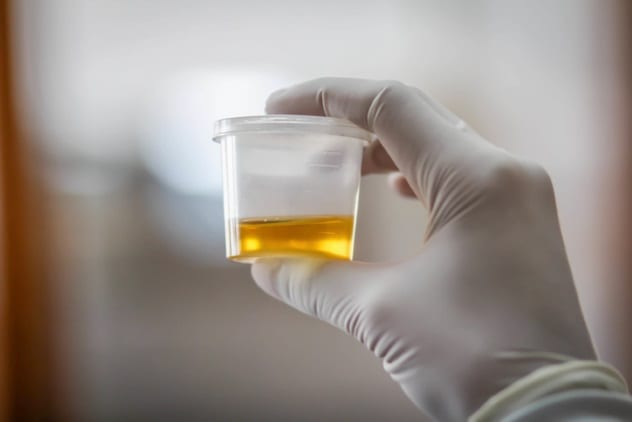
The tongue is a versatile organ, and before the discovery of accurate chemical analyses, it was one of a doctor’s most useful tools. It might strike us as a bit disgusting, but tasting a patient’s urine gave their medic an insight into what may have been wrong with them.
In 6 BC, a Hindu doctor named Sushrata wrote a description of “Honey Urine,” a disease marked by unusually sweet urine. He noted that ants would crowd around it and sampled it for himself.[2] Today, we know that the urine of untreated diabetics contains high levels of sugar. In the 17th century, an English doctor documented the same thing, describing a disease known as “the pissing evil,” which caused urine that was “wonderfully sweet as if it were imbued with honey or sugar.”
The sweetness of a diabetic’s urine could also be detected without resorting to tasting it. In one case, it was spotted when sugar crystals were noticed on the black shoes of a patient. They had formed as splashes of urine dried.
8 Rabbit And Frog Pregnancy Tests

For most of human history, women have generally had to wait many months to discover if they were pregnant. Only with the telling bump of their belly could they be certain. In the early 20th century, that changed with the development of rabbit and frog pregnancy tests.
It was found that when a woman is pregnant, her urine would contain a hormone called human chorionic gonadotropin (hCG). Testing directly for this would have been too difficult and costly to be a useful procedure at the time. However, when hCG is injected into a female rabbit, it causes telltale swelling and color changes in the rabbit’s ovaries.[3] So a woman’s urine would be injected into a rabbit to see if she was pregnant. At first, this required the death of the rabbit to allow the ovaries to be examined, though later, nonlethal methods were found.
The rabbit test was soon replaced with the frog test. The African clawed frog would have urine injected into it, too. If the frog produced eggs the next day, then the pregnancy test was positive, as hCG causes the frogs to ovulate. This test had the benefit of being cheaper than the rabbit test and had easier-to-recognize results. It was the standard pregnancy test into the 1950s.
7 Diagnosis By TV

In an episode of House, the medical marvel kidnaps the star of his favorite TV soap opera when he spots a symptom he feels needs investigating. Such a wacky event could never happen in real life, surely? Well, it did—minus the kidnapping.
Tarek El Moussa, host of home renovation show Flip or Flop, was diagnosed with cancer when a viewer wrote in. The viewer had been watching a marathon of the show and noticed that El Moussa had a lump on his throat.[4] Most viewers, like El Moussa himself, probably wrote it off as nothing more than one of those lumps and bumps we all have. But Ryan Reade was a nurse, and her concerns were justified.
El Moussa’s doctors discovered that the lump was thyroid cancer that had spread to his lymph nodes. El Moussa had the tumor removed and underwent chemotherapy. He later got to thank nurse Ryan on TV, crediting her with probably saving his life.
6 Ear Folds Can Reveal Heart Disease
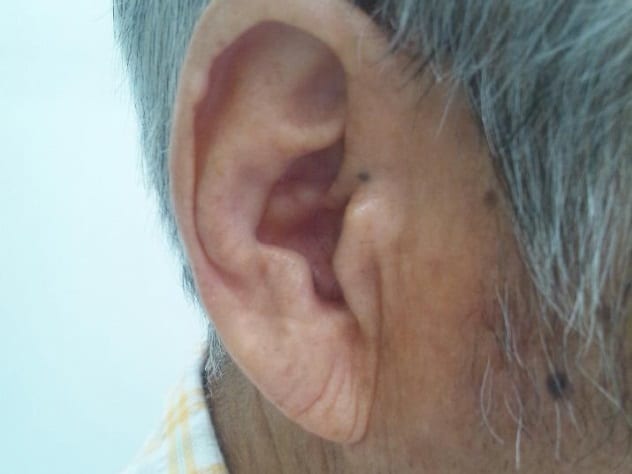
In 1973, Dr. Sanders T. Frank wrote a letter to The New England Journal of Medicine, in which he drew attention to the link between patients with angina and a diagonal fold in their earlobes. This symptom is now known as Frank’s sign and has been linked to heart disease and strokes.[5] A recent study found that in people who have had a stroke, Frank’s sign was present in over 75 percent of cases.
There is no medical consensus as to why problems of the heart and blood flow should cause this diagonal fold. Some suggest that it is caused by problems in the arteries present in that area. Others contend that it is related to increased cell aging.
While Frank’s sign has only recently been recognized, historical cases have been found. Busts of the Roman emperor Hadrian show his ears with pronounced diagonal folds. How did Hadrian die? Ancient sources describe him as having symptoms that would today be linked to congestive heart failure.
5 Dementia Can Be Diagnosed From Writing

Iris Murdoch, the brilliant philosopher and novelist, succumbed to Alzheimer’s Disease, which left her confused and unable to remember anything. This cruel disease would eventually prevent her from writing any more, but it may have left clues which will allow others with the disease to be diagnosed earlier.
By studying Murdoch’s 26 novels, scientists were able to compare her use of language over time. While her style and construction of sentences remained the same, her vocabulary dwindled toward the end of her career.[6] Another author whose works have been studied, Agatha Christie, showed a 20-percent decrease in her vocabulary over the course of her career. It may be no coincidence that her late novel Elephants Can Remember is centered around a female novelist struggling with a failing memory.
4 Licking Cystic Fibrosis Patients’ Skin

“The child will soon die whose brow tastes salty when kissed.” So runs a rather morbid line from a 19th-century children’s almanac.[7] The book didn’t say why this should be so, but we now know that the cause of a salty-tasting child was most likely cystic fibrosis.
Cystic fibrosis is a fairly common genetic disease which affects the lungs, pancreas, and digestive tract. A mutation alters the way that many secretions are made in the body, creating a whole range of medical complications. One of the secretions which is changed is sweat. In people with cystic fibrosis, it is unusually salty. Many parents who kiss their child may have detected this difference.
In the 17th and 18th centuries, writers of folk wisdom declared that salty skin was a symptom of bewitching. They may have gotten the cause wrong, but the results were much the same. Before modern medicine, the lives of those with cystic fibrosis were universally short.
3 Sniffing Out Parkinson’s

We’ve already seen how capable dogs are at smelling diseases, but it turns out that the human nose may be just as useful in detecting medical problems. Joy Milne’s husband was a sufferer of Parkinson’s disease. This degenerative illness of the nervous system leaves people unable to control their movements. But six years before her husband was diagnosed with Parkinson’s, Joy knew something was different. She could smell it.[8]
Occasionally, she would smell something she described as a “musty” aroma from her husband, but she didn’t really think anything of it. It was only after joining a charity for Parkinson’s disease and finding that many others with the condition smelled the same to her that she mentioned it to scientists. Intrigued, they tested her. They gave her 12 T-shirts, six that had been worn by people with Parkinson’s and six worn by those without. The initial result was 11 out of 12. Joy identified all of the Parkinson’s patients but also swore that she could detect it in one member of the control group. Mere months later, that person was diagnosed with Parkinson’s disease.
The scientists are now trying to identify what the compound is that Joy Milne is able to smell in hopes of making a clinical test which will allow early detection of the disease.
2 Red Eyes In Photos

Many digital cameras these days come equipped with the ability to remove “red eyes” from photos. Red eyes are caused by the camera flash being reflected off the blood-rich retina at the back of the eye. It can be annoying, but it is, in fact, a sign of good health.
Tara Taylor posted a photo of her young daughter on Facebook, which showed her with one red eye and the other glowing yellow. Concerned friends pushed her to take her daughter to a doctor. The doctors discovered that the child had Coats’ disease, a buildup of cholesterol in the blood vessels of the eye that can cause blindness.[9] Thanks to catching it early, doctors were able save her sight.
Retinoblastoma is a cancer of the retina which mostly affects children and can also be detected by looking at how the eyes react to a camera flash. While Coats’ disease looks yellow, retinoblastomas look white. So next time a picture of your child comes out with two red eyes, consider it a blessing.
1 Pregnancy Tests—For Men
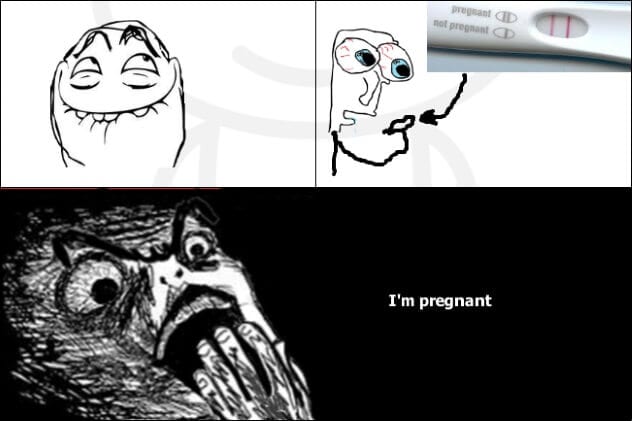
We saw how rabbits and frogs were used to detect the hormone hCG to tell if women were pregnant. Modern pregnancy tests look for the same hormone. Given how rarely men get pregnant, you can understand how shocked one man was when he used a pregnancy test, and it came back positive.
It’s not known why the man used a pregnancy test he found in his cabinet, but when he got the surprising result, he told a friend. That friend, known only as “CappnPoopdeck,” decided to make her friend’s experience into a comic and posted it to Reddit. Along with the usual jokes, one commenter suggested that the man go to see a doctor. Men producing hCG may have testicular cancer. Doctors did indeed find a small tumor, and the man was treated while it was still at an early stage.
Not all testicular cancers produce hGC, but giving men pregnancy tests can be a useful way of detecting tumors at an early stage. A British teenager with an unknown cancer was advised to use a pregnancy test, which revealed his testicular cancer in 2015.[10] Now there is even more reason for men to fear a positive pregnancy test.
Read more about the weird side of medicine on 10 Of The Weirdest Medical Procedures Out There and 10 Bizarre Medieval Medical Practices.






